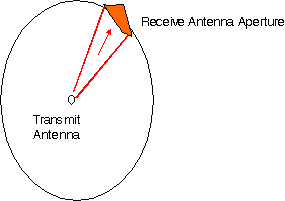
 |
www.WirelessCommunication.NLChapter: Wireless Channels |

The power density w at distance d from a transmitter with power p_T and antenna gain G_T is
w =p_T G_T/ (4 pi d^2)..
The available power p_R at a receive antenna with gain G_R is
![]()
where A is the effective area or `aperture' of the antenna, with G_R = 4pi A / ![]() ^2. The wavelength
^2. The wavelength ![]() is c
/ f_c with c the velocity of light and f_c the carrier frequency. The product G_T p_T is called the effectively radiated power (ERP) of the transmitter.
is c
/ f_c with c the velocity of light and f_c the carrier frequency. The product G_T p_T is called the effectively radiated power (ERP) of the transmitter.
While cellular telephone operator mostly calculate in received powers, in the planning of the coverage area of broadcast transmitters, the CCIR recommends the use of the electric field strength E at the location of the receiver. The conversion is
![]() .
.
![]()
As the propagation distance increases, the radiated energy is spread over the surface of a sphere of radius d, so the power received decreases proportional to d^-2. Expressed in dB, the received power is
![]()
Engineers speak about a "20 log d" path loss law..